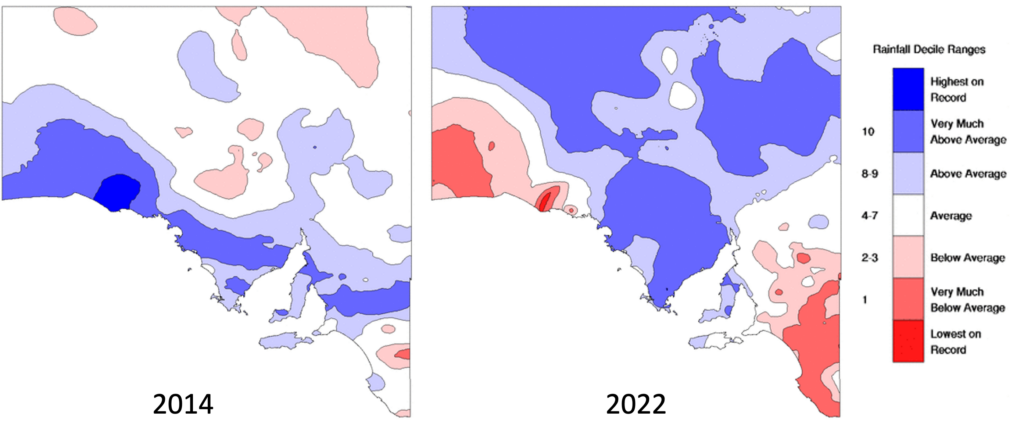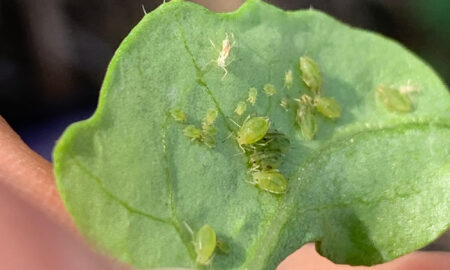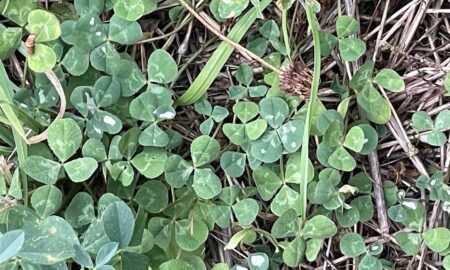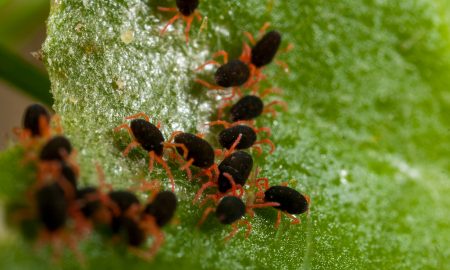Summary
- This year’s green bridge means large numbers of aphids are likely in autumn and winter, which increases the risk of viruses impacting a variety of grain crops
- The green peach aphid transmits many plant viruses, including turnip yellows virus (TuYV)
- Conditions are similar those that lead to TuYV outbreaks in south-eastern Australia in 2014
- Careful monitoring for green peach aphids and virus symptoms over the coming months is recommended
Green bridge and aphid risk
We’ve been harping on about the green bridge this year, but for good reason. The wet conditions over summer and resulting growth of weed hosts results in a high risk for many pests that can affect establishing crops in autumn.
These conditions are particularly favourable for aphids, which carry the additional risk of virus transmission. Aphids survive in summer by taking refuge in small, isolated pockets of suitable habitat (such as the green bridge). Rainfall over summer and autumn often results in more aphids in the green bridge which can result in large numbers of winged aphids flying into crops.
Significant numbers of aphids are already being reported in central New South Wales and Victoria. Many aphids are able to persist throughout the year, but a sharp drop in temperature over the coming weeks will help reduce their numbers. However, if the mild weather continues this could mean significant aphid issues at crop establishment.
In this article we focus on the green peach aphid, however there are many other crop aphids that could prove to be problematic this year. Many of these species will not only cause direct feeding damage to crops but have the ability to transmit important plant viruses. For example, the oat aphid (a widespread pest of cereals) is an efficient vector of barley yellow dwarf virus (BYDW).
Green peach aphid
Green peach aphid (Myzus persicae) is a common pest of several broadacre crops (canola and pulses), broadleaf pastures and horticultural crops throughout Australia. They infest or seek refuge on several broadleaf weed species. Unfortunately, the number of plants that can host green peach aphids is very large. Recent surveys by Cesar Australia have shown the hosts which are particularly important in cropping systems include volunteer canola, wild radish, wild mustard, shepherd’s purse, clovers, medics and marshmallow.
One of the difficulties with green peach aphid management is that seed treatments and other chemical solutions might not be effective because of widespread insecticide resistance.
More information on green peach aphid identification and insecticide resistance.
Turnip yellows virus and green peach aphids
Turnip yellows virus (TuYV, formerly known as beet western yellows virus) is transmitted by the green peach aphid, and can cause serious disease in Australian canola crops. It is carried within the aphid and transmitted to healthy plants during feeding for the entire lifecycle of the aphids. Green peach aphids have a very high transmission efficiency for TuYV (96%) which means that they can quickly and efficiently spread the virus.
TuYV outbreak in 2014
In 2014, south-eastern Australia experienced its most recent large scale crop virus epidemic. The widespread outbreak of TuYV occurred in South Australia, western Victoria and New South Wales, primarily impacting canola crops. There were widespread infestations of green peach aphid during the autumn and winter of 2014 which contributed to the virus outbreak. The early start in the season and early sowing of crops also contributed to the severity of the outbreak.
Reports of crop failures in South Australia began in June and by September yield loss was as high as 75% in some areas. It is estimated that up to 10,000 ha of canola in South Australia was severely affected by the outbreak.
More information on the 2014 outbreak here.
The figure below shows that the rainfall conditions in the led up to the outbreak in South Australia in 2014 are similar to what we are seeing this year; a very wet summer with the high potential for aphid build up. If the mild temperatures continue into autumn like they did in 2014 then it’s going to be more important than ever to keep an eye out for green peach aphid and TuYV.

Early warning system for green peach aphid and TuYV
A TuYV early warning system, developed and led by DPIRD’s Ben Congdon, was trialled in Victoria and Southern NSW in 2020 (13 sites) and 2021 (16 sites) in canola paddocks. With the assistance of a large network of participating agronomists and growers, this early warning system involved the deployment yellow sticky traps and testing the migrating aphids caught for TuYV using a rapid and sensitive RNA detection technique.
In the 2021 growing season, TuYV was detected in aphids at 94% of sites in varying densities and timings. The highest number of detections occurred during April and May, which corresponds to a key migration period of the green peach aphid. In eastern Victoria, we saw an early onset of high aphid numbers in April, accompanied by high TuYV incidence. Data from the early warning system showed canola paddocks with high numbers of TuYV-carrying aphids had higher incidence of TuYV at GS30.
Current conditions indicate high aphid and virus risk
The TuYV early warning system showed that despite relatively dry starts to 2020 and 2021, and minimal to moderate green bridge over those summers, there were still relatively high numbers of virus-carrying aphids detected in autumn of 2020 and 2021 in many areas.
Given there is a much greater green bridge in most areas of South Australia, Victoria and southern NSW this year, we are very likely to see higher background levels of green peach aphids, and possibly TuYV. Based on the high levels of virus detected over the last two years there are concerns about potentially large spread of TuYV infection in canola for 2022.
Management recommendations
TuYV systemically infects plants and cannot be sprayed out post-infection like a fungal disease. Therefore, control needs to be focussed on prevention rather than cure. The following strategies can be used to reduce the risk of large populations of virus transmitting green peach aphid.
- Reduce the green bridge as much as possible around canola paddocks. Ensure the paddock is weed-free for at least 10 days prior to sowing.
- Do not sow crops early in the season; sow on usual dates, to avoid early aphid flights.
- Conduct regular monitoring for green peach aphids from sowing to stem-elongation (tips for aphid identification here).
- Where possible, sow into standing stubble; aphids prefer to land on bare earth and are less likely to move into crops in standing stubble until after the rosette stage.
- Consider the use of a selective insecticide during the critical period (April-June) if large numbers of green peach aphid are detected in crops.
More information on green peach aphid management here and free insecticide resistance testing here.
If you notice TuYV symptoms, get tested
If crops show any TuYV symptoms (e.g. stunted growth, leaf purpling) we recommend getting plants tested for TuYV presence. Testing is needed in order to correctly identify the source of the problem, as abiotic stress such as waterlogging and nutrient deficiency can cause similar symptoms. Reporting this information to the industry is critical to assess the area-wide effects of TuYV, but also to better predict and manage future TuYV outbreaks.
TuYV testing is available through Agriculture Victoria or NSW DPI.
More info on TuYV symptoms and management here
Further resources
Acknowledgements
Thank you to Dr Ben Congdon and Dr Paul Umina for contributions to this article.
The TuYV early warning system research is part of the DIPRID Boosting Grains project 2019SP02, led by DPIRD research scientist Dr Ben Congdon in collaboration with Cesar Australia, and is also supported through the Grains Research and Development Corporation. We acknowledge all those participants involved in the TuYV early warning system deployed in Victoria and NSW in 2020 and 2021.
Cover image: Photo by Marielle Babineau (Cesar Australia)





